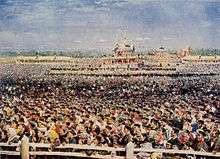Khodynka Tragedy
.jpg)
The Khodynka Tragedy (Russian: Ходынская трагедия) was a human stampede that occurred on 30 May [O.S. 18 May] 1896, on Khodynka Field in Moscow, Russia during the festivities following the coronation of the last Russian Emperor Nicholas II, which resulted in the deaths of 1,389 people.
Events

Nicholas II was crowned Tsar of Russia on 26 May [O.S. 14 May] 1896. Four days later, a banquet was going to be held for the people at Khodynka Field. In the area of one town square, theaters, 150 buffets for distribution of gifts, and 20 pubs were built for the celebrations. Near the celebration square was a field that had a ravine and many gullies. On the evening of 29 May, people who had heard rumours of coronation gifts from the tsar began to gather in anticipation. The gifts which everybody was to receive were a bread roll, a piece of sausage, pretzels, gingerbread, and a commemorative cup.
At about 6 o'clock in the morning of the celebration day, several thousand people (estimates reached 500,000[1]) were already gathered on the field. Rumours spread among the people that there was not enough beer or pretzels for everybody, and that the enamel cups contained a gold coin. A police force of 1,800 men failed to maintain civil order, and in a catastrophic crowd-crush and resulting panic to flee the scene, 1,389 people were trampled to death, and roughly 1,300 were otherwise injured.[2] Most of the victims were trapped in the ditch and were trampled or suffocated there. Despite the tragedy, the program of festivities continued as planned elsewhere on the large field, with many people unaware of what had happened. The Tsar and his wife made an appearance in front of the crowds on the balcony of the Tsar's Pavilion in the middle of the field around 2 p.m. By that time the traces of the incident had been cleaned up.
Aftermath

The parties, receptions and balls following the Coronation were darkened by the catastrophe at Khondinka[sic], where 2,000 people were crushed to death. The same day as the catastrophe, I was taking a walk along the Khondinka[sic] and I met many groups of people coming back from that site and carrying the Tsar's gifts. The strange thing, though, was that not one person mentioned the catastrophe, and I did not hear about it until the next morning, at the Governor General's palace, where General Prefect of Police Vlasovski brought a special report. Grand Duke Serge Alexandrovich was very depressed by what had happened; he gave Vlasovski orders to return to him every hour with detailed reports on the progress of the investigation into the causes of the disaster.
Nicholas and Alexandra were informed about the tragedy, but not immediately. A festive ball was scheduled that night at the French embassy to Russia. Nicholas thought it best not to attend, because it would make him appear he had no grief over the loss of his subjects. However, the younger brothers of Emperor Alexander III still wielded much influence at the court, and Nicholas's uncles viewed not attending the ball as a slap in the face of Paris, which could be even worse for him than to appear uncaring about the Russian people. Despite the deaths, Nicholas attended the ball for diplomatic reasons. The new Emperor and his wife went the next day visiting people who had been hospitalized as a result of the stampede.
The government distributed a large amount of aid to the families of the dead, and a number of minor officials were dismissed. In the aftermath of the accident, the negligence and the tone-deaf response of the imperial authorities caused further public indignation in Russia. The Emperor's uncle, Grand Duke Sergei Alexandrovich, then Governor-General of Moscow, became known as "the Prince of Khodynka" and the populace began to call the Emperor "Nicholas the Bloody".[3]
"19th of May. Saturday. Until now, everything was going, thank God, like clockwork, but today there was a great mishap. The crowd staying overnight at Khodynka, awaiting the start of the distribution of lunch and mugs pushed against buildings and there was a terrible crush, and awful to say trampled around 1300 people !! I found out about it at 10 1/2 hours before the report by [minister of war] Vannovski; a disgusting impression was left by this news. At 12 1/2 we had lunch and then Alix [Czarina] and I went to Khodynka to be present at this sad "national holiday." Actually there was nothing going on: we looked from the pavilion at the huge crowd that surrounded the stage from which the orchestra played all the time the anthem and "Glory." Went to Petrovsky [palace], where at the gate I received several delegations and then entered the yard. Here dinner was served under four tents for all township heads. I had to make a speech, and then another for the assembled marshals of the nobility. After going around the table, we left for the Kremlin. Dinner at Mama's at 8. Went to the ball at [French ambassador] Montebello's. It was very nicely arranged, but the heat was unbearable. After dinner, left at 2." From the diary of Emperor Nicholas II[4]
References
- ↑ Leyda, Kino: A History of the Russian and Soviet Film, (London: George Allen and unwin Ltd., 1960), 19.
- 1 2 "Timelines.com". 17 October 2010.
- ↑ "Трагедия на Ходынском поле" [The tragedy on the Khodynka Field]. ИМПЕРАТОР НИКОЛАЙ II. Omsk State University. Retrieved 2016-07-05.
Сергей Александрович с тех пор получил в народе титул "князя Ходынского", а Николай II стал именоваться «Кровавым». [Sergei Aleksandrovich from this time received the title "Prince of Khodynka" amongst the people, while Nicholas II came to be called "the Bloody".]
- ↑ http://www.rus-sky.com/history/library/diaris/1896.htm
External links
- Memories of Alexei Volkov on the Khodynka Tragedy—view from inside the palace
Coordinates: 55°47′14″N 37°31′52″E / 55.78722°N 37.53111°E